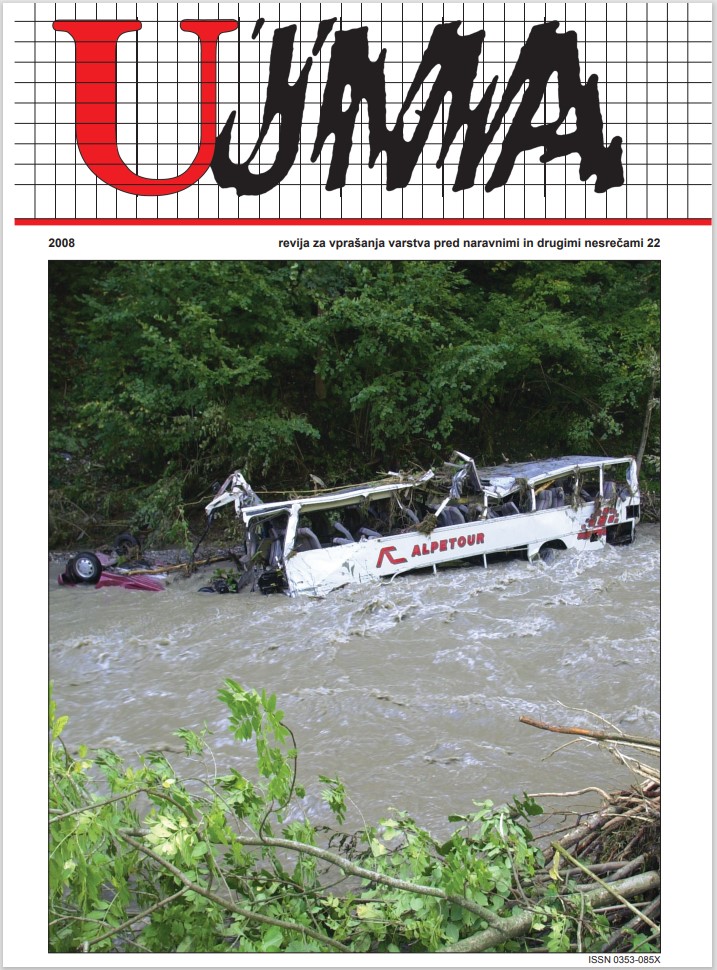IMPACT OF CLIMATIC CHANGE ON FLOOD AND EROSION CONTROL
Abstract
Natural disasters which in recent years affected many places around the world confirm the assertions of climatologists who warn that global climate change will result in ever more extreme weather conditions. Natural disasters therefore also occur in area which were once considered relatively safe. There is increasing uncertainty with regard to sufficiency and appropriateness of the existing or planned systems of protection from natural disasters. Slovenia is mountainous and hilly country where natural conditions are suitable for land covers such as erosion and torrents to develop. Although recent years have been relatively fortunate, Slovenia will remain no exception and will inevitably face similar or even worse riguours of the weather than the one in September 2007 which affected a considerable part of Slovenia's torrential regions. While the available data only provide for estimates and the identification of trends, they are nevertheless sufficient for systematic measures, adapted to the individual regions. Damage inflicted by natural disasters can only be mitigated through systematic, long-term, integral and sustainable measures. In practice this means a set of appropriate measures within an integral system of managing dangers and risks, coupled with the participation of all irelevant players. One should be aware that the issue of providing safety from erosion and torrents is not limited solely to physical safety of the population in the affected areas, but rather has broader economic and demographic perspectives. In a country where nearly half of the territory is represented by areas potentially endangered by erosion, ensuring safety from erosion and torrents is also an important political issue. The price of preventing is significantly lower than the price of rehabilitation. This paper highlights the importance of regular maintenance of the existing water management regimes and protective installations. As for the inadequately maintained systems for protection from natural disasters, their actual functionality is all the more uncertain given the forecasts of increasing extreme weather conditions. It is therefore urgent that at least the originally designed and envisaged functionality of the installations and protective systems be provided through adequate maintenance and that their protective function preferably be upgraded. Inadequately maintained installations may deceive by giving a false sense of safety and may hinder the urgent and productive dialogue on the remaining risks. By receiving appropriate information, we as individuals can contribute considerably to a greater safety.
References
Horvat, Aleš, 2002b. Erozija. V: Ušeničnik, Bojan (ur.). Nesreče in varstvo pred njimi. Ljubljana: Uprava RS za zaščito in reševanje Ministrstva za obrambo, str. 341—345
Horvat, Aleš, 2002c. Varstvo pred erozijo. V: Ušeničnik, Bojan (ur.). Nesreče in varstvo pred njimi. Ljubljana: Uprava RS za zaščito in reševanje Ministrstva za obrambo, str. 533—541
Horvat, Aleš, Papež, Jože. 2004. Informacijski sistem o naravnih nesrečah na območju Alp = DIS-ALP: Alpine region disaster information system. Ujma (Ljublj.), št. 17/18, str. 312—314
Kajfež - Bogataj, L., 2006. Podnebne spremembe in nacionalna varnost; Ujma št. 20, str. 170—176
National Centre of Competence in Research (NCCR) Climate, 2007. http://www.nccr-climate.unibe.ch
PLANALP, 2008, Platforma za naravne nevarnosti v okviru Alpske konvencije; dokumentacija
PLANAT, MeteoSchweiz, 2007. Climate Change and Natural Disasters in Switzerland; Bern, 4 str.
Polajnar, Janez, 2005. Hudourniki so nepredvidljivi; Mladina, 29. avgust 2005
PUH, 1995. Poročilo o varstvu pred erozijo in hudourniki v Sloveniji, Ljubljana, 22 str.
PUH, 1998. Vodni ujmi jeseni 1998 v Sloveniji in smernice za varstvene in varnostne ukrepe – Študijska naloga, št. proj. IV-108/98, MO / URSZR, Ljubljana, 96 str.
PUH, 2000. Ocena in prikaz trenutnega stanja izvedenih ureditev za stabilizacijo povirja na Nadiži in njenih pritokih ter na hudourniku Šijak; Str. naloga, št. proj. IV-50/00, MOP/URSZVN, 38 str.
PUH, 2001a. Analiza posledic neurij novembra 2000 na hudourniških območjih Slovenije; 2001 – Študijska naloga, št. proj. IV-8/01, MO / URSZR, Ljubljana, 135 str.
PUH, 2001b. Problematika erozije in poplavljanja na hudourniškem območju Drave, št. IV-86/01, MOP, Ljubljana, 98 str.
PUH, 2003. Ocena in prikaz stanja izvedenih ureditev za stabilizacijo povirja na reki Soči s Koritnico od Loga Čezsoškega gorvodno; Str. naloga, št. proj. IV-16/03, MOPE, 138 str.
Downloads
Published
Issue
Section
License

This work is licensed under a Creative Commons Attribution-NonCommercial-NoDerivatives 4.0 International License.
The articles are made available to the public under Creative Commons Attribution-NonCommercial-NoDerivatives 4.0 International (CC BY-NC-ND 4.0).


